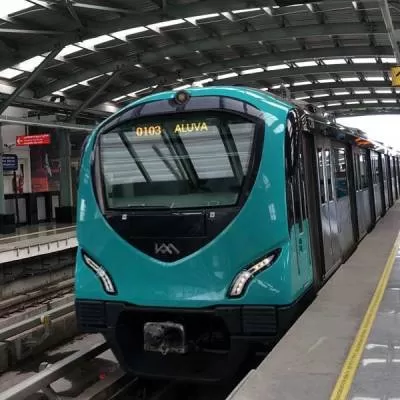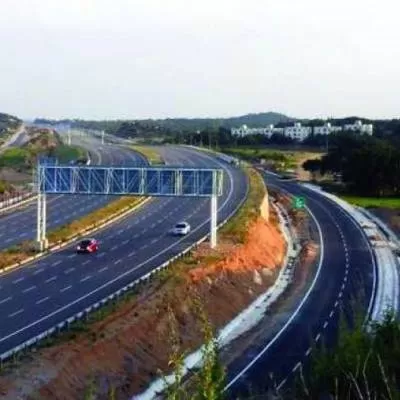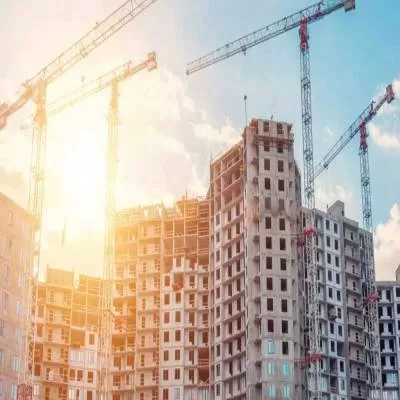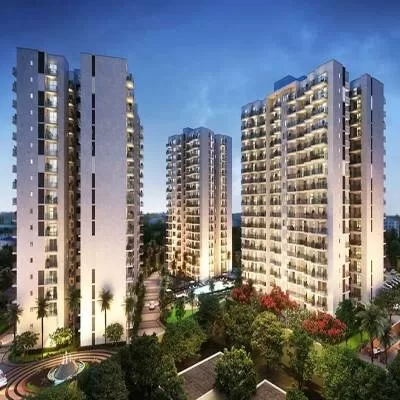- Home
- Real Estate
- Building Style
Building Style
In the next in a series of interviews with prominent civil engineers, Janaki Krishnamoorthi meets Kishore Tidke,
Chief Operating Officer - Construction Management, Lodha Group.
Supervising the planning, coordination and execution of over 44 projects simultaneously in Mumbai, Pune and Hyderabad is no walk in the park. But Kishore Tidke, Chief Operating Officer - Construction Management, Lodha Group, takes it all in his stride with consummate ease. After more than three decades in the profession, the incessant travel and 12-hour workdays are now second nature to him. “The profession as such demands that kind of involvement; I’m lucky my wife hasn’t divorced me so far!” quips Tidke, who has created nearly 35 million sq ft of space.
Born and raised in Nashik, Tidke acquired his civil engineering degree from the University of Pune. Subsequently he joined M Tech (structural engineering) at Indian Institute of Technology (IIT) Mumbai. However, he had to quit his studies at the fag end of the course as he was selected for the Indian Engineering Services (IES) and had to join the Ministry of Defence. IIT granted him permission to take a break and rejoin the course within two years. But owing to work pressure, he never got around to completing it. But he had already acquired the necessary knowledge at the course and gained much more from his varied experience in defence as well as in Muscat - where he worked for five years - and India.
“It has been an extremely challenging and rewarding experience,” says Tidke. “Creating landmarks gives you immense satisfaction and that’s what I like about this profession.” What does he dislike? The regulatory maze in which the construction business has to function. Now, Tidke, who has handled a variety of projects from residential complexes to IT Parks, is looking forward to building his dream project, World One, being developed by Lodha Group at Lower Parel. The 117-storey tower, the tallest in India at present, promises to provide its occupants an international living experience. “Apart from the height, there will be many other firsts in this project, including some unconventional, innovative construction technologies,” says Tidke, but declines to elaborate further. He, however, goes on to share his thoughts and experience on other issues related to his profession and the industry:
Work philosophy
I have always based my decisions on three principles: Give the customer something more than what is promised. The only way to do a job is the right way regardless of the costs and consequences. And finally, plan the resources according to the requirement of a project and not the other way round.
Qualities of a civil engineer
Perseverance and the ability to work under demanding circumstances are very essential. A civil engineer has to remain calm in any situation; if he loses his cool, he can make serious errors in judgement and judgements are very important in every project. One must also have the ability to interface at all levels, from labourers, contractors and architects to managers and even company directors. To be in civil engineering, one must be ready to move out of the comfort zone. The time to get to work is fixed but returning home is not; at times, one may have to work the whole night. Also, one needs the right attitude to ensure that a job is done right irrespective of the costs and consequences. The chalta hai approach can be very dangerous here.
Construction scenario
Until the late 1980s, the construction scenario was not encouraging as cement was a controlled commodity. Projects were few, largely developed by the government. As a result, the industry was not evolving and our projects were way behind in quality compared to international standards. My experience in Muscat was an eye opener for me as I witnessed the construction quality and speed at which projects were being executed. Eventually, cement was decontrolled in 1989 and the industry geared up for growth. Around that time, many industry professionals who had gone abroad also returned to India. There was a change in mindset, particularly in Mumbai. At that time Anthony Remedios, a renowned civil engineer and consultant, was educating civil engineers about good construction practices. He trained engineers, including me, at Raheja Corp. From then, the quality in the construction industry took a turn for the better. We are still not on par with international standards but we are catching up.
Earlier, everything was seen through the narrow prism of cost, which has changed now. Developers, at least reputed ones, have come to realise that it is important to complete the project on time with the right quality standards. Exposure to happenings abroad and removal of resource constraints have led to the change. Today, buyers, particularly institutional buyers with their own real-estate professional set up, are well informed and sometimes even we get to learn from them about new techniques and construction practices. Such interaction adds a lot of value to projects.
Dearth of civil engineers
Between 1995 and 2005, there was a marked preference for the IT sector that offered ample opportunities and attractive pay scales. In that decade, very few civil engineers came out of institutions. Some engineering colleges even closed down their civil engineering department as there were few takers. However, after the Lehman Brothers bankruptcy in 2008 and its effect on the IT sector, youngsters began to return to civil engineering. I won’t say there has been a major shift but at least the profession is getting its due. Today, the opportunities in both IT and civil engineering are more or less on a par and salaries are also at a pretty comfortable level. But as there was a void for almost a decade, we are facing a shortage of engineers. Owing to this void, we also have a problem finding engineers at junior levels with just four to five years of experience.
Kishore Tidke:
• BE (Civil) from University of Pune
• Completed coursework for M Tech in Structural Engineering from IIT Mumbai
• After passing Indian Engineering Services (1976) joined the Ministry of Defence and worked in the Air Force and Navy in Nasik and Mumbai (1976-1982)
• Moved to Muscat (1982-1987)
• Joined K Raheja Corp Mumbai as Senior Vice-President (1987-2009)
• Headed engineering operations at Sheth Developers, Mumbai, for a brief period of four months
• Joined Lodha Developers, Mumbai, as Chief Operating Officer - Construction Management (2009 till date)
Challenging projects:
Project: Aircraft hangars for Air Force near Nashik
Client: Ministry of Defence
Period: 1976-79
Salient features: Construction of an aircraft maintenance base comprising six, large-span steel structures, taxiways and aprons, maintenance bays and storage facilities.
Challenges: The greatest challenge was to complete the steel structures in half the time they would normally take. While racing to meet the deadline, a major problem surfaced with the huge electrically operated doors failing to function. It took just two days to identify the problem but two months to set it right after working day and night. Tidke explains what went wrong: “These doors were supported by steel frames at the top, which got slightly displaced owing to the deflection of wind girders at both ends. While analysing the cause, we discovered that the failure had occurred not because of any design flaw but the wrong construction sequence. We had to remove the doors, pull the girders to their original position and brace the entire structure so that it did not sway back.”
Project: MindSpace (IT park), Cybercity, Hyderabad
Developer: K Raheja Corp
Period : Ongoing; began in 2003 and is being developed in phases (70 per cent complete)
Salient features: Thirty buildings with built-up area of over 13 million sq ft with state-of-the-art infrastructure, which has become a preferred destination for many multinational companies and one of the largest employment hubs in Hyderabad.
Innovative technology: These days, e-offices need large columnless spaces that require extensive use of post-tensioning. A number of other new features rarely used before in power distribution and building automation were also included. The green building concept, which has since gained considerable importance, was also introduced, involving the induction of several new technology applications like variable frequency drives, high-efficiency chillers, high-performance glass and high-level automation to monitor power consumption at multiple locations within a building.
Major challenges: The terrain was difficult with rocks and boulders that had to be blasted without damaging buildings located close to the worksite. “As blasting would cause vibrations in the earth somewhat similar to an earthquake, though not of the same magnitude, we decided to use a seismograph to ensure the vibrations were kept well within permissible limits,” reveals Tidke. Accordingly, a seismograph was used to monitor particle accelerations caused by each blast. Other challenges were on account of logistics involved owing to the huge volume of construction going on simultaneously compounded by the closure of the main road for heavy vehicles, holding up material supplies during daytime. Yet another challenge involved the import of a large number of equipment necessary to meet the IT industry’s infrastructure requirements within compressed time schedules while going through the rigours of various clearances!
Project: Casa Bella, Casa Bella Gold, Lodha Golf Links - Kalyan Shil Road, Palava
Developer: Lodha Group
Period: Ongoing; started in 2010 and the first phase is on in all three projects. Total development expected to be completed in 15 years
Salient features: Three large projects with towers and villas under development simultaneously at one site providing myriad comforts and luxuries including a clubhouse, swimming pools, jogging track, mall, multiplex, mini theatre, school, polyclinic, fire station and a nine-hole golf course along with full infrastructure.
Challenges: The huge volume of development is the first major challenge. “One cannot imagine the enormous resources required from materials and machinery to manpower,” elaborates Tidke. “Further, this area does not have many municipal amenities and whatever is available would not be sufficient to meet the size of the development we are undertaking. So we are also building self-sustainable infrastructure from roads and drainage to water and power. In short, it is almost like building a suburb, something that has not happened in Mumbai so far.” Finding sufficient skilled labour for such large-scale development was yet another challenge. “As skilled labour is in short supply, we will opt for mechanisation wherever possible and use new construction technologies that require fewer men.”
In the next in a series of interviews with prominent civil engineers, Janaki Krishnamoorthi meets Kishore Tidke, Chief Operating Officer - Construction Management, Lodha Group. Supervising the planning, coordination and execution of over 44 projects simultaneously in Mumbai, Pune and Hyderabad is no walk in the park. But Kishore Tidke, Chief Operating Officer - Construction Management, Lodha Group, takes it all in his stride with consummate ease. After more than three decades in the profession, the incessant travel and 12-hour workdays are now second nature to him. “The profession as such demands that kind of involvement; I’m lucky my wife hasn’t divorced me so far!” quips Tidke, who has created nearly 35 million sq ft of space. Born and raised in Nashik, Tidke acquired his civil engineering degree from the University of Pune. Subsequently he joined M Tech (structural engineering) at Indian Institute of Technology (IIT) Mumbai. However, he had to quit his studies at the fag end of the course as he was selected for the Indian Engineering Services (IES) and had to join the Ministry of Defence. IIT granted him permission to take a break and rejoin the course within two years. But owing to work pressure, he never got around to completing it. But he had already acquired the necessary knowledge at the course and gained much more from his varied experience in defence as well as in Muscat - where he worked for five years - and India. “It has been an extremely challenging and rewarding experience,” says Tidke. “Creating landmarks gives you immense satisfaction and that’s what I like about this profession.” What does he dislike? The regulatory maze in which the construction business has to function. Now, Tidke, who has handled a variety of projects from residential complexes to IT Parks, is looking forward to building his dream project, World One, being developed by Lodha Group at Lower Parel. The 117-storey tower, the tallest in India at present, promises to provide its occupants an international living experience. “Apart from the height, there will be many other firsts in this project, including some unconventional, innovative construction technologies,” says Tidke, but declines to elaborate further. He, however, goes on to share his thoughts and experience on other issues related to his profession and the industry: Work philosophy I have always based my decisions on three principles: Give the customer something more than what is promised. The only way to do a job is the right way regardless of the costs and consequences. And finally, plan the resources according to the requirement of a project and not the other way round. Qualities of a civil engineer Perseverance and the ability to work under demanding circumstances are very essential. A civil engineer has to remain calm in any situation; if he loses his cool, he can make serious errors in judgement and judgements are very important in every project. One must also have the ability to interface at all levels, from labourers, contractors and architects to managers and even company directors. To be in civil engineering, one must be ready to move out of the comfort zone. The time to get to work is fixed but returning home is not; at times, one may have to work the whole night. Also, one needs the right attitude to ensure that a job is done right irrespective of the costs and consequences. The chalta hai approach can be very dangerous here. Construction scenario Until the late 1980s, the construction scenario was not encouraging as cement was a controlled commodity. Projects were few, largely developed by the government. As a result, the industry was not evolving and our projects were way behind in quality compared to international standards. My experience in Muscat was an eye opener for me as I witnessed the construction quality and speed at which projects were being executed. Eventually, cement was decontrolled in 1989 and the industry geared up for growth. Around that time, many industry professionals who had gone abroad also returned to India. There was a change in mindset, particularly in Mumbai. At that time Anthony Remedios, a renowned civil engineer and consultant, was educating civil engineers about good construction practices. He trained engineers, including me, at Raheja Corp. From then, the quality in the construction industry took a turn for the better. We are still not on par with international standards but we are catching up. Earlier, everything was seen through the narrow prism of cost, which has changed now. Developers, at least reputed ones, have come to realise that it is important to complete the project on time with the right quality standards. Exposure to happenings abroad and removal of resource constraints have led to the change. Today, buyers, particularly institutional buyers with their own real-estate professional set up, are well informed and sometimes even we get to learn from them about new techniques and construction practices. Such interaction adds a lot of value to projects. Dearth of civil engineers Between 1995 and 2005, there was a marked preference for the IT sector that offered ample opportunities and attractive pay scales. In that decade, very few civil engineers came out of institutions. Some engineering colleges even closed down their civil engineering department as there were few takers. However, after the Lehman Brothers bankruptcy in 2008 and its effect on the IT sector, youngsters began to return to civil engineering. I won’t say there has been a major shift but at least the profession is getting its due. Today, the opportunities in both IT and civil engineering are more or less on a par and salaries are also at a pretty comfortable level. But as there was a void for almost a decade, we are facing a shortage of engineers. Owing to this void, we also have a problem finding engineers at junior levels with just four to five years of experience. Kishore Tidke: • BE (Civil) from University of Pune• Completed coursework for M Tech in Structural Engineering from IIT Mumbai• After passing Indian Engineering Services (1976) joined the Ministry of Defence and worked in the Air Force and Navy in Nasik and Mumbai (1976-1982)• Moved to Muscat (1982-1987)• Joined K Raheja Corp Mumbai as Senior Vice-President (1987-2009)• Headed engineering operations at Sheth Developers, Mumbai, for a brief period of four months• Joined Lodha Developers, Mumbai, as Chief Operating Officer - Construction Management (2009 till date) Challenging projects: Project: Aircraft hangars for Air Force near Nashik Client: Ministry of DefencePeriod: 1976-79Salient features: Construction of an aircraft maintenance base comprising six, large-span steel structures, taxiways and aprons, maintenance bays and storage facilities.Challenges: The greatest challenge was to complete the steel structures in half the time they would normally take. While racing to meet the deadline, a major problem surfaced with the huge electrically operated doors failing to function. It took just two days to identify the problem but two months to set it right after working day and night. Tidke explains what went wrong: “These doors were supported by steel frames at the top, which got slightly displaced owing to the deflection of wind girders at both ends. While analysing the cause, we discovered that the failure had occurred not because of any design flaw but the wrong construction sequence. We had to remove the doors, pull the girders to their original position and brace the entire structure so that it did not sway back.” Project: MindSpace (IT park), Cybercity, Hyderabad Developer: K Raheja Corp Period : Ongoing; began in 2003 and is being developed in phases (70 per cent complete) Salient features: Thirty buildings with built-up area of over 13 million sq ft with state-of-the-art infrastructure, which has become a preferred destination for many multinational companies and one of the largest employment hubs in Hyderabad.Innovative technology: These days, e-offices need large columnless spaces that require extensive use of post-tensioning. A number of other new features rarely used before in power distribution and building automation were also included. The green building concept, which has since gained considerable importance, was also introduced, involving the induction of several new technology applications like variable frequency drives, high-efficiency chillers, high-performance glass and high-level automation to monitor power consumption at multiple locations within a building. Major challenges: The terrain was difficult with rocks and boulders that had to be blasted without damaging buildings located close to the worksite. “As blasting would cause vibrations in the earth somewhat similar to an earthquake, though not of the same magnitude, we decided to use a seismograph to ensure the vibrations were kept well within permissible limits,” reveals Tidke. Accordingly, a seismograph was used to monitor particle accelerations caused by each blast. Other challenges were on account of logistics involved owing to the huge volume of construction going on simultaneously compounded by the closure of the main road for heavy vehicles, holding up material supplies during daytime. Yet another challenge involved the import of a large number of equipment necessary to meet the IT industry’s infrastructure requirements within compressed time schedules while going through the rigours of various clearances! Project: Casa Bella, Casa Bella Gold, Lodha Golf Links - Kalyan Shil Road, Palava Developer: Lodha GroupPeriod: Ongoing; started in 2010 and the first phase is on in all three projects. Total development expected to be completed in 15 yearsSalient features: Three large projects with towers and villas under development simultaneously at one site providing myriad comforts and luxuries including a clubhouse, swimming pools, jogging track, mall, multiplex, mini theatre, school, polyclinic, fire station and a nine-hole golf course along with full infrastructure.Challenges: The huge volume of development is the first major challenge. “One cannot imagine the enormous resources required from materials and machinery to manpower,” elaborates Tidke. “Further, this area does not have many municipal amenities and whatever is available would not be sufficient to meet the size of the development we are undertaking. So we are also building self-sustainable infrastructure from roads and drainage to water and power. In short, it is almost like building a suburb, something that has not happened in Mumbai so far.” Finding sufficient skilled labour for such large-scale development was yet another challenge. “As skilled labour is in short supply, we will opt for mechanisation wherever possible and use new construction technologies that require fewer men.”























